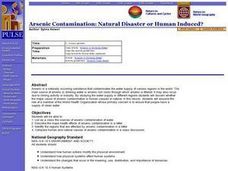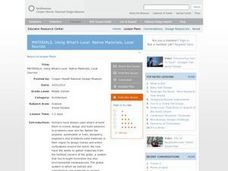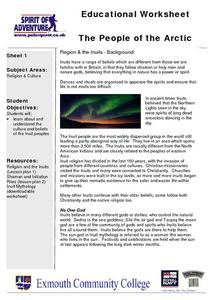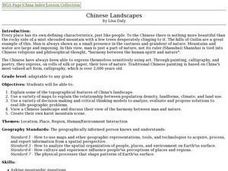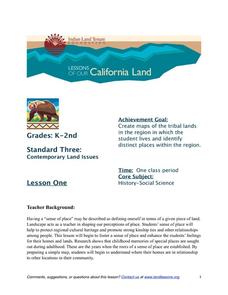Curated OER
Arsenic Contamination: Natural Disaster or Human Induced?
Young scholars list as a class the sources of arsenic contamination of water. They describe the major health effects of arsenic contamination in a letter. Students identify the regions that are affected by it.
Curated OER
A Primary Industry and its Environmental Impact in a Region
Learners research and write about the importance of a primary industry in an assigned region of Canada. They study the environmental impact of developing a primary resource.
Curated OER
Regions of the US: Gulf Stream, States and Their Capitals
Fifth graders identify one way of dividing the US into geographical regions and then consider alternate ways of doing the same. They locate each of the fifty states and their capitals on a map. They research the Gulf Stream region.
Curated OER
Landscape Picture Map: Natural Features
Students discover six landscapes. In this natural features instructional activity, students review the meaning and examples of natural features. Students use a landscape picture map to identify six natural features.
Curated OER
Modern Japan: Tsunami Relief
High schoolers participate in a lesson that is concerned with modern day tsunami relief in Japan. They conduct research and chart the regional alert centers. Students also note the worldwide effort to help those in need.
Curated OER
Endangered Relationships
Students study the interrelationship between the horseshoe crab and red knot. In this ecology lesson, students explain why several species became extinct. They research about endangered species found in their region.
Curated OER
Nature's Air Conditioner
Students observe the process of transpiration in leaves. They measure how much water a leaf gives off in a 24-hour period, calculate the volume, and answer discussion questions.
Curated OER
MATERIALS, Using What’s Local: Native Materials, Local Sources
Students consider the development of different societies. In this environmental building instructional activity, students consider local resources and how societies choose to use them. Students use their findings to design a 'green'...
Curated OER
People of the Arctic
Read to learn all about the religion and belief systems of the Arctic-dwelling Inuits. This resource includes an easy-to-follow reading passage that is seven paragraphs in length, and five great critical thinking questions.
Australian Government
The Great Artesian Basin
Covering 23% of the continent and holding 64,900 cubic kilometers of water, the Great Artesian Basin is the primary source of water for much of inland Australia. Using detailed student worksheets, experiments, and case studies,...
Southwest Florida Water Management District
WaterWeb - Conservation and Water Supply
If 71% of our planet is covered with water, why do we need to bother conserving water? Find out with these activities designed for middle and high school environmental scientists. From reading articles to solving crossword puzzles, to...
Polar Trec
Foraging for Fish in a Melting Arctic
How much do you know about the black guillemot of the Arctic region? With great background information, images, and a quick discussion, the class will learn all about the plight of the foraging seabird as they play a fun game. First,...
Curated OER
Location, Location, Location: Civilization's Ultimate Advantage
Students discover how geographical advantages, locational and regional, ultimately led to western Eurasian societies' disproportionate accounting of world power and innovation. They utilize a workbook which can be downloaded within this...
Curated OER
Northwest Hawaiian Islands
Students compare and contrast places around the world. Students analyze the effects of human activity on the physical environment and devise plans to address the consequences. Students also focus on geographical topics such as formation...
Curated OER
A Matter of Survival
Fourth graders dance with inspiration from wild animals. In this creative movement lesson, 4th graders watch a video clip and then move like an animal might move in their natural surroundings.
Curated OER
Chinese Landscapes
Students explain some of the topographical features of China's landscape. They view a Chinese landscape and discuss their view of the harmony between man and nature, then create their own karst mountain scene.
Curated OER
Whoa! Slow Down-Some of You!
Students analyze demographic data (growth rate, natural increase, fertility rate, crude birth rates, and crude death rates) and determine which areas of the world contain the fastest and slowest growth rates. They construct population...
Curated OER
Sweden: The Landscape
Students imagine they are taking a trip around Sweden. They create a nature journal for their trip including the description of the landscape, climate, animals and plants. They are to give details to make it seem real. Students may use...
Curated OER
Looking to Our Environment
Eighth graders studied an environmental region in Illinois. The wetlands, swamps, woodlands and prairies were chosen. They research this region and create a picture that looks as if they are looking out the window. They had to have at...
Curated OER
Virtual Vacation
Students are members of teams traveling and exploring the Pacific States Region of the United States via the Internet. Each team travels virtually to its destination to become experts on geography, history, tourism, nature, and economics.
Curated OER
Africa: Introduction, Geography and Mapping
Students study the geography of Africa through the use of maps. They locate, distinguish, and describe the relationships among varying regional and global patterns of geographic phenomena such as landforms, climate, and natural resources.
Indian Land Tenure Foundation
Create a Map
Do your learners have a connection to their natural environment? Create neighborhood maps together with your little learners. The lesson starts as the class talks about where they live and what their homes look like. They review their...
Curated OER
Weather Patterns
Middle schoolers research to determine weather patterns and natural hazards most likely to affect their region.
Curated OER
Habitats: must live with them....cannot live without them.
Students conduct an internet study regarding habitat, ecosystem, biome and the region they live in. They observe the habitat by visiting a State Park and observing the organisms in their habitat. In addition, they create their own...
Other popular searches
- Natural Regions of Florida
- Natural Regions of Texas
- Natural Regions in Guyana
- Geographic Natural Regions
- Natural Regions World Map
- Natural Regions Map Pictures
- Natural Regions of Guyana
- Natural Regions Map Picturs
- Natural Regions of Canada
- Flordia 6 Natural Regions
- Florida 6 Natural Regions
